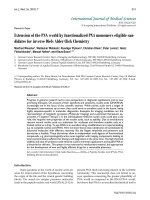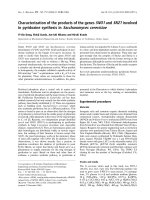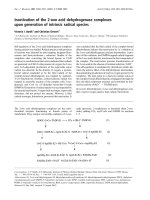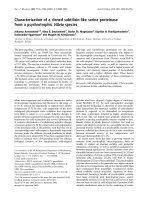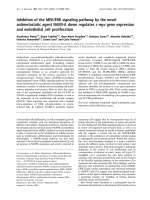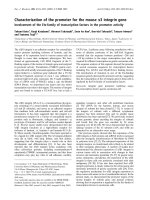Báo cáo Y học: Characterization of the exopolysaccharide produced by Streptococcus thermophilus 8S containing an open chain nononic acid doc
Bạn đang xem bản rút gọn của tài liệu. Xem và tải ngay bản đầy đủ của tài liệu tại đây (561.35 KB, 9 trang )
Characterization of the exopolysaccharide produced
by
Streptococcus thermophilus
8S containing an open chain
nononic acid
Elisabeth J. Faber, Daan J. van Haaster, Johannis P. Kamerling and Johannes F. G. Vliegenthart
Bijvoet Center, Department of Bio-Organic Chemistry, Section of Glycoscience and Biocatalysis, Utrecht University, Utrecht,
the Netherlands
The exopolysaccharide produced by Streptococcus thermo-
philus 8S in reconstituted skimmed milk is a heteropolysac-
charide containing
D
-galactose,
D
-glucose,
D
-ribose, and
N-acetyl-
D
-galactosamineinamolarratioof2:1:1:1.
Furthermore, the polysaccharide contains one equivalent of
a novel open chain nononic acid constituent, 3,9-dideoxy-
D
-
threo-
D
-altro-nononic acid, ether-linked via C-2 to C-6 of an
additional
D
-glucose per repeating unit. Methylation analy-
sis and 1D/2D NMR studies (
1
Hand
13
C) performed on the
native polysaccharide, and mass spectrometric and NMR
analyses of the oligosaccharide obtained from the polysac-
charide by de-N-acetylation followed by deamination and
reduction demonstrated the ÔheptaÕsaccharide repeating unit
to be:
in which Sug is 6-O-(3¢,9¢-dideoxy-
D
-threo-
D
-altro-nononic
acid-2¢-yl)-a-
D
-glucopyranose.
Keywords: exopolysaccharide; lactic acid bacteria; nononic
acid; Streptococcus thermophilus;structuralanalysis.
Microbial exopolysaccharides (EPSs) are employed in the
food industry as viscosifying, stabilizing, emulsifying and
gelling agents [1]. The texturizing properties of EPSs in
fermented dairy products [2] in combination with the
GRAS (generally recognized as safe) status of EPS-produ-
cing lactic acid bacteria, make these EPSs of interest for the
food industry. To understand the relationship between the
structure of EPSs and their physical properties, structural
studies have been performed on EPSs produced by various
species of the Lactobacillus, Lactococcus,andStreptococcus
genera ([3,4], and references cited therein).
ThelacticacidbacteriumStreptococcus thermophilus is
used in combination with other lactic acid bacteria like
Lactobacillus delbrueckii ssp. bulgaricus as starter culture for
fermentations in dairy industry. In the last decade, the
primary structure of the EPSs secreted by seven S. thermo-
philus strains [5–9] were elucidated. A number of the EPSs
are structurally related polysaccharides and include the EPSs
produced by S. thermophilus Sfi12 [6], OR 901 [7], Rs [8], Sts
[8], and S3 [9], of which the OR 901, Rs and Sts EPSs
have identical repeating units. These EPSs are charac-
terized by the presence of a repeating pentameric back-
bone containing the fi3)-a-
D
-Galp-(1fi3)-a-
L
-Rhap-(1fi2)-
a-
L
-Rhap-(1fi2)-a-
D
-Galp-(1fi3)-Hexp-(1fisequence,
wherein the fifth residue is a-
D
-Glcp for Sfi12, a-
D
-Galp for
OR 901, Rs and Sts, and b-
D
-Galp for S3. Furthermore, the
EPSs differ in the attachment site of the side chain, as well as
in the composition of the side chain.
Recently [10], we reported for the EPS produced by
S. thermophilus 8S the occurrence of a Glc residue etherified
at O-6 with a novel open chain nononic acid, i.e. 6-O-(3¢,9¢-
dideoxy-
D
-threo-
D
-altro-nononic acid-2¢-yl)-
D
-glucopyra-
nose. Here, we report the complete structure of this EPS.
MATERIALS AND METHODS
Culture conditions of microorganism and isolation
of polysaccharide
S. thermophilus 8S, obtained from NIZO food research
(Ede, the Netherlands), was cultured in pasteurized recon-
stituted skimmed milk containing 0.2% (w/w) casiton. After
16 h at 37 °C, trichloroacetic acid was added (4%, w/w),
and the bacterial cells and precipitated proteins were
removed by centrifugation (30 min, 16 300 g,4°C). Two
volumes of EtOH were added to the supernatant, and
precipitated material was isolated by centrifugation (30 min,
16 300 g,4°C). An aqueous solution of the precipitated
material was extensively dialyzed against running tap water,
and, after removal of insoluble material by centrifugation,
again two volumes of EtOH were added. The precipi-
tate formed was re-dissolved in water, and subsequently
Correspondence to J. P. Kamerling, Bijvoet Center, Department of
Bio-Organic Chemistry, Section of Glycoscience and Biocatalysis,
Utrecht University, Padualaan 8, NL-3584 CH Utrecht,
the Netherlands, Fax: + 31 30 2540980,
E-mail:
Abbreviations: EPS, exopolysaccharide; GRAS, Generally Recognized
as Safe; Hex, hexose; HMQC, heteronuclear multiple-quantum
coherence; n-EPS, native exopolysaccharide; Pent, pentose; Rha,
rhamnose; Sug, 6-O-(3¢,9¢-dideoxy-
D
-threo-
D
-altro-nononic acid-
2¢-yl)-a-
D
-glucopyranose; Tal, Talose
(Received 3 June 2002, revised 30 August 2002,
accepted 18 September 2002)
Eur. J. Biochem. 269, 5590–5598 (2002) Ó FEBS 2002 doi:10.1046/j.1432-1033.2002.03266.x
subjected to a fractionated precipitation at 30, 40, 50 and
60% (v/v) acetone. The precipitated material collected
from the 30 and 40% (v/v) acetone fractions were purified
further by gel filtration on a column of Sephacryl S-500
(150 · 2.2 cm, Pharmacia) irrigated with 50 m
M
NH
4
HCO
3
using refractive index detection.
De-N-acetylation and deamination
A solution of polysaccharide (5 mg) in anhydrous hydrazine
(0.5 mL), containing hydrazine sulfate (25 mg), was stirred
under argon for 20 h at 100 °C. Then, the solution was
concentrated in vacuo and coconcentrated with toluene. The
residue was dissolved in water and the solution was desalted
on graphitized carbon [11]. A solution of the obtained de-N-
acetylated polysaccharide in aq. 33% HOAc (2 mL), aq.
5% NaNO
2
(2 mL), and water (0.5 mL) was stirred for 2 h
at room temperature, then neutralized using 4
M
NH
4
OH,
and desalted on graphitized carbon. After lyophilization,
the residue was treated with NaBD
4
(20 mg) in 1
M
NH
4
OH for 1 h at room temperature, then neutralized
using 4
M
HOAc, and desalted on graphitized carbon. The
obtained material was fractionated by high-pH anion-
exchange chromatography with pulsed amperometric
detection (HPAEC-PAD) on a CarboPac PA-1 pellicular
anion-exchange column (25 cm · 9 mm, Dionex). The
column was eluted with a gradient of NaOAc in 0.1
M
NaOH (20–250 m
M
NaOAc at a rate of 11 m
M
Æmin
)1
)ata
flow rate of 4 mLÆmin
)1
. PAD-detection was carried out
with a gold working electrode, and triple-pulse ampero-
metry (pulse potentials and durations: E
1
0.05 V, 300 ms;
E
2
0.65 V, 60 ms; E
3
)0.95 V, 180 ms) was used.
Carboxyl reduction
Carboxyl-reduction of the native polysaccharide was per-
formed as described [12]. A solution of polysaccharide
(2 mg) in 2-(4-morpholino)-ethanesulfonic acid (0.2
M
,
1 mL, pH 4.75), containing N-ethyl-N-(3-dimethylamino-
propyl)-carbodiimidehydrochloride (30 mg), was stirred for
90 min at room temperature. After reduction with NaBD
4
(10 mg, 1 h), the obtained material was neutralized with
1.5
M
HCl, desalted on graphitized carbon, and lyophilized
prior to analysis. To obtain a complete carboxyl reduction
the procedure was repeated twice.
Gas-liquid chromatography and mass spectrometry
GLC analyses were performed on a CP-Sil 5CB fused silica
capillary column (Chrompack CP9002, 25 m · 0.32 mm)
using a temperature program from 140°C to 300 °Cat
4 °Cmin
)1
followed by 10 min at 300 °C. GLC-EIMS
analyses were carried out on a Fisons MD800/8060 system
(electron energy, 70 eV) equipped with a DB-1 fused silica
capillary column (J & W Scientific, 30 m · 0.32 mm) using
a temperature program from 140 °C to 300 °Cat4 °CÆmin
)1
followed by 10 min at 300 °C. Positive-ion mode nanoES-
CID tandem mass spectra were obtained on a Micromass
Q-TOF hybrid tandem mass spectrometer equipped with a
nanospray ion source (Bijvoet Center, Department of
Biomolecular Mass Spectrometry) essentially according to
[13]. Argon was used as a collision gas with a collision energy
of 75 eV.
Monosaccharide and methylation analysis
For monosaccharide analysis samples were subjected to
methanolysis (methanolic 1
M
HCl, 18 h, 85 °C), followed
by re-N-acetylation and trimethylsilylation (1 : 1 : 5 hexa-
methyldisilazane-trimethylchlorosilane-pyridine), and the
resulting mixtures of methyl glycosides were analyzed on
GLC [14,15]. The absolute configurations of the monosac-
charides were determined by GLC analysis of the trimeth-
ylsilylated (–)-2-butyl glycosides [16,17]. For methylation
analysis, poly- and oligosaccharides were permethylated
using CH
3
I and solid NaOH in Me
2
SO as described
previously [18]. The methylated saccharides were subse-
quently hydrolyzed with 2
M
trifluoroacetic acid (2 h,
120 °C) and reduced with NaBD
4
. After neutralization
and removal of boric acid by coevaporation with methanol,
the mixture of partially methylated alditols was acetylated
with acetic anhydride (3 h, 120 °C), and analyzed by GLC
and GLC–EIMS [14,19].
NMR spectroscopy
Prior to NMR analysis, samples were exchanged twice in
99.9 atom% D
2
O (Isotec) with intermediate lyophilization
and finally dissolved in 99.96 atom% D
2
O (Isotec). 1D and
2D NMR spectra were recorded on a Bruker AMX-500
spectrometer (Bijvoet Center, Department of NMR Spectro-
scopy) at probe temperatures of 27 or 64 °C. Chemical
shifts for
1
H were expressed in p.p.m. relative to internal
acetone (d 2.225) and for
13
Ctothea-anomeric signal of
external[1–
13
C]glucose (d
C-1
92.9). 1D
1
H spectra were
recorded with a sweep width of 5000 Hz in data sets of
16384 points. The HOD signal was suppressed by applying
a WEFT pulse sequence [20]. 2D TOCSY spectra were
recorded using a ÔcleanÕ MLEV-17 mixing sequence with an
effective spin-lock time of 15–300 ms. 2D NOESY experi-
ments were performed with mixing times of 100 and 200 ms,
and 2D ROESY experiments were recorded with a
mixing time of 300 ms. The natural abundance
13
C–
1
H
2D heteronuclear multiple-quantum coherence (HMQC)
experiment was recorded without decoupling during acqui-
sition of the
1
H free induction decay (FID). In the 2D
experiments the HOD signal was suppressed by presatura-
tion for 1 s. Homonuclear 2D spectra were recorded using a
spectral width of 4032 Hz in both directions, and the
heteronuclear HMQC experiment with a spectral width of
4032 Hz and 16350 Hz for
1
Hand
13
C, respectively.
Resolution enhancement of the spectra was performed by
a Lorentzian-to-Gaussian transformation or by multiplica-
tion with a squared-bell function phase shifted by p/(2.3),
and when necessary, a fifth order polynomial baseline
correction was performed. All NMR data were processed
using the
TRITON NMR
software package (Bijvoet Center,
Department of NMR Spectroscopy).
RESULTS
Isolation, purification, and composition
of the polysaccharide
The EPS produced by S. thermophilus 8S in reconstituted
skimmed milk was isolated as an ethanol precipitate from
the protein-free supernatant. The EPS was purified by
Ó FEBS 2002 Structure of the EPS produced by S. thermophilus 8S (Eur. J. Biochem. 269) 5591
fractionated acetone precipitation, followed by gel filtra-
tion of the 30 and 40% acetone-precipitated fractions on
Sephacryl S-500. The purity of the isolated EPS was
confirmed by 1D
1
H NMR spectroscopy.
GLC monosaccharide analysis, including absolute con-
figuration determination, of the native EPS (n-EPS) showed
the presence of
D
-Gal,
D
-Glc,
D
-Rib, and
D
-GalNAc in a
molar ratio of 2 : 1 : 1 : 1. In addition, GLC peaks were
observed originating from a novel constituent, 6-O-(3¢,9¢-
dideoxy-
D
-threo-
D
-altro-nononic acid-2¢-yl)-
D
-glucopyra-
nose [10]. The molar ratio of this constituent in terms of
peak areas was 0.7 compared to Glc. Methylation analysis
of n-EPS revealed, besides the occurrence of a product
stemming from the novel constituent, the presence of 4-
substituted Glcp, 4-substituted Galp, 4-substituted Galp-
NAc, and 2-substituted Ribf (for evidence of the pyranose
ring forms, see NMR analysis) in a molar ratio of
1.0 : 1.7 : 0.6 : 0.7. Methylation analysis of n-EPS after
carboxyl-reduction (cr-EPS) yielded also the substitution
pattern of the novel constituent: 7¢-substituted 6-O-(3¢,9¢-
dideoxy-nonitol-2¢-yl)-Glcp [10]. Based on these results, a
linear heteropolysaccharide is indicated.
The 1D
1
H NMR spectrum of n-EPS (Fig. 1A) contained
six well-resolved anomeric signals, A–F, following increas-
ing anomeric proton chemical shift values. The anomeric
signal data of the residues A (d 4.473,
3
J
1,2
7.9 Hz),
B (d 4.621,
3
J
1,2
8.0 Hz), and C (d 4.766,
3
J
1,2
7.9 Hz)
demonstrated b-pyranose ring forms, and those of residues
D (d 4.952,
3
J
1,2
3.7 Hz) and E (d 5.178,
3
J
1,2
3.1 Hz)
a-pyranose ring forms. In addition, the H-1 signal data of
residue F (d 5.358,
3
J
1,2
< 2 Hz) suggested a furanose ring
form. Methyl and methylene signals were detected at d1.224
and d 1.88, respectively, originating from the nononic acid
part in residue D, being the novel constituent 6-O-(3¢,9¢-
dideoxy-
D
-threo-
D
-altro-nononic acid-2¢-yl)-a-
D
-glucopyra-
nose (Sug, vide infra). Furthermore, a characteristic signal at
d 2.057 was observed, originating from the N-acetyl group
of GalpNAc.
De-N-acetylation and deamination of the native
polysaccharide
Owing to the presence of GalNAc in the linear polysac-
charide chain (vide supra), n-EPS could be subjected to
de-N-acetylation followed by deamination to generate an
oligosaccharide repeating unit fragment. After reduction
with NaBD
4
, the material obtained was fractionated
on CarboPac PA-1. This yielded one major fraction, which
had the monosaccharide composition of Gal, Rib and Glc
in the molar ratio of 2 : 1 : 1 (GLC analysis), the deami-
nation product of GalpNAc (2,5-anhydro-Tal-ol-1-d)ina
molar ratio of 1 in terms of peak areas compared to Glc,
Fig. 1. 500-MHz
1
H NMR spectrum of (A)
n-EPS produced by S. thermophilus 8S,
recorded in D
2
Oat64°C, and of (B) the
oligosaccharide-alditol generated by de-N-
acetylation/deamination/reduction of n-EPS,
recorded in D
2
Oat27°C. Signals marked
with an asterisk (*) stem from impurities.
Sug ¼ 6-O-(3¢,9¢-dideoxy-
D
-threo-
D
-altro-
nononic acid-2¢-yl)-a-
D
-glucopyranose.
5592 E. J. Faber et al.(Eur. J. Biochem. 269) Ó FEBS 2002
and traces of product stemming from Sug. Methylation
analysis of the oligosaccharide demonstrated the presence
of terminal Galp, 4-substituted Galp, 4-substituted Glcp,
2-substituted Ribf, and 4-substituted 2,5-anhydro-Tal-ol-
1-d in a molar ratio of 1.1 : 0.9 : 1.0 : 0.8 : 0.8 (based on
peak areas).
To obtain information on the sequence of the monosac-
charides, the isolated oligosaccharide was analyzed by
nanoES-CID tandem mass spectrometry. The obtained
fragment ions were labeled according to the nomenclature
of Domon and Costello [21]. In the ES spectrum a sodium-
cationized [M + Na]
+
pseudomolecular ion was observed
at m/z 1204 corresponding to Hex
3
Pent
1
Sug
1
anhydroHex
1
-
ol-1-d.Furthermore,a[M+Na]
+
ion was present at m/z
1186, arising from the loss of water due to the formation of
an intraresidual lactone in the nononic acid part of Sug [10].
The tandem mass spectrum obtained on collision activation
of the pseudomolecular ion at m/z 1204 (Fig. 2) contained a
series of sodium-cationized B
n
and Y
n
sequence ions at m/z
479, 641, 877 and 1039, and m/z 586, 748, 910 and 1042,
respectively, consistent with a linear ÔheptaÕsaccharide
HexfiPentfiHexfiHexfiSugfianhydro-Hex-ol-1-d.In
addition to the B
n
and Y
n
ions, a secondary fragment ion
was observed at m/z 421 originating from the loss of
anhydro-Hex-ol-1-d from the Y
2
ion (586–165).
In the 1D
1
H NMR spectrum of the isolated oligosac-
charide (Fig. 1B) five anomeric signals were observed at
d 4.475 (residue A,
3
J
1,2
7.9 Hz; b-pyranose), d 4.625 (residue
B,
3
J
1,2
7.8 Hz; b-pyranose), d 5.037 (residue D,
3
J
1,2
3.9 Hz;
a-pyranose), d 5.194 (residue E,
3
J
1,2
3.4 Hz; a-pyranose),
and d 5.408 (residue F,
3
J
1,2
< 2 Hz; furanose), respec-
tively. The absence of signals under the HOD signal (d 4.76)
was confirmed by a 1D
1
H NMR experiment at 64 °C(data
not shown). In addition to signals in the anomeric region
(d 4.4–5.5), well-resolved signals were observed at d 1.205
(CH
3
)andd 1.83 (CH
2
), originating from the nononic
acid part in residue D. Comparison of the
1
HNMR
spectrum of the oligosaccharide with that of n-EPS revealed
C to be the GalpNAc residue, since the anomeric signal of C
is absent in the spectrum of the oligosaccharide. The
1
H
resonances listed in Table 1, were assigned essentially as
described for n-EPS (vide infra). The signal at d 4.40,
assigned to C-ol H-4 by comparison with 2,5-anhydro-
D
-
Tal-ol [22], was used as starting point for the assignment of
the C-ol H-2,3,5,6a,6b resonances. Interresidual connectiv-
ities deduced from a 2D ROESY spectrum, yielded evidence
for the E-(1fi2)-F-(1fi4)-A-(1fi4)-B-(1fi7¢)-D-(1fi4)-C-ol
sequence. The combined results from chemical analysis,
mass spectrometry, and NMR studies allowed the oligo-
saccharide to be formulated as a ÔheptaÕsaccharide with the
following structure:
2D NMR spectroscopy of the native polysaccharide
By means of 2D TOCSY, 2D NOESY, and
13
C-
1
HHMQC
experiments most of the
1
H chemical shifts for n-EPS could
be assigned (Table 1). As an example, the TOCSY spectrum
with a mixing time of 300 ms is presented in Fig. 3.
The
1
H resonances of A H-2,3,4, B H-2,3,4,5,6a,6b, C H-
2,3,4,5, D H-2,3,4,5, E H-2,3,4,5, and F H-2,3,4,5a,5b were
assigned via connectivities with the corresponding anomeric
signals in the TOCSY spectra using increasing mixing times.
The A H-5 resonance was determined on the A H-4 track in
the TOCSY spectrum. The overlap of A H-3 and A H-5 was
confirmed in the
13
C–
1
HHMQCspectrum(Fig.4).The
resonances of A H-6a,6b were assigned via their correlation
to the corresponding
13
C resonance in the
13
C–
1
HHMQC
Fig. 2. Positive-ion mode nanoES-CID tan-
dem mass spectrum of m/z 1204 ([M + Na]
+
)
of the oligosaccharide-alditol generated by
de-N-acetylation/deamination/reduction of
n-EPS.
Ó FEBS 2002 Structure of the EPS produced by S. thermophilus 8S (Eur. J. Biochem. 269) 5593
Table 1.
1
Hand
13
C NMR chemical shifts of native EPS (n-EPS) recorded in D
2
Oat64 °C and of the isolated oligosaccharide alditol (oligo) recorded
in D
2
Oat27 °C. Values given in p.p.m relative to the signal of internal acetone at d 2.225 (
1
H) and the a-anomeric signal of external [1–
13
C]glucose
at d 92.9 (
13
C). Coupling constants are given in parentheses; n.d. not determined.
Residue Proton n-EPS oligo Carbon n-EPS
A fi4)-b-
D
-Galp-(1fi H-1 4.473 (7.9) 4.475 (7.9) C-1 103.6 (160)
H-2 3.54 3.53 C-2 70.8
H-3 3.77 3.79 C-3 73.7
H-4 4.03
a
4.04 C-4 77.2
H-5 3.76 3.77 C-5 75.4
H-6a 3.77 n.d. C-6 61.8
H-6b 3.77 n.d.
B fi4)-b-
D
-Glcp-(1fi H-1 4.621 (8.0) 4.625 (7.8) C-1 103.9 (161)
H-2 3.44 3.43 C-2 74.1
H-3 3.71 3.69 C-3 75.0
H-4 3.70 3.69 C-4 79.5
H-5 3.64 3.61 C-5 75.5
H-6a
b
3.96 3.95 C-6 60.3
H-6b
b
3.83 3.84
C fi4)-b-D-GalpNAc-(1fi H-1 4.766 (7.9) – C-1 103.5 (162)
H-2 3.93 – C-2 53.8
H-3 3.85 – C-3 71.5
H-4 4.03
a
– C-4 77.2
H-5 3.72 – C-5 76.0
H-6a 3.77 – C-6 61.8
H-6b 3.77 –
NAc 2.057 – COCH
3
COCH
3
22.7
178.6
C-ol fi4)-2,5-anhydro- H-1 – n.d. C-1 –
D
-Tal-ol-1-d H-2 – 3.99 C-2 –
H-3 – 4.24 C-3 –
H-4 – 4.40 C-4 –
H-5 – 4.24 C-5 –
H-6a
b
– 3.88 C-6 –
H-6b
b
– 3.83
D fi7¢)-Sug-(1fi H-1 4.952 (3.7) 5.037 (3.9) C-1 100.7 (171)
H-2 3.58 3.59 C-2 72.7
H-3 3.83 3.79 C-3 73.4
H-4 3.56 3.53 C-4 72.2
H-5 4.20 4.13 C-5 71.8
H-6a
b
3.87 3.89 C-6 69.0
H-6b
b
3.63 3.60
H-2¢ 4.10 4.12 C-2¢ 69.8
H-3¢ab 1.88 1.83 C-3¢ 34.9
H-4¢ 3.96 3.99 C-4¢ 79.8
H-5¢ 3.93 3.97 C-5¢ 73.6
H-6¢ 3.71 3.68 C-6¢ 71.6
H-7¢ 3.82 3.81 C-7¢ 85.1
H-8¢ 4.02 4.00 C-8¢ 68.5
CH
3
H-9¢ 1.224 (6.7) 1.205 (6.4) C-9¢ 18.0
E fi4)-a-
D
-Galp-(1fi H-1 5.178 (3.1) 5.194 (3.4) C-1 98.5 (172)
H-2 3.78 3.86 C-2 69.2
H-3 4.04 3.94 C-3 70.4
H-4 4.18 4.00 C-4 78.3
H-5 4.11 4.11 C-5 71.6
H-6a 3.74 n.d. C-6 60.3
H-6b 3.74 n.d.
F fi2)-b-
D
-Ribf-(1fi H-1 5.358 (< 2) 5.408 (< 2) C-1 107.7 (176)
H-2 4.25 4.26 C-2 80.7
H-3 4.26 4.26 C-3 71.0
5594 E. J. Faber et al.(Eur. J. Biochem. 269) Ó FEBS 2002
spectrum. The H-6 signal of residue C could be assigned via
the C H-4 TOCSY track. The D H-6a,6b resonances were
determined in the
13
C–
1
H HMQC spectrum, taking into
account that residue D is substituted at O-6, resulting in a
characteristic track in this spectrum. Furthermore, the
chemical shifts of E H-6a,6b could be assigned via the E H-5
TOCSY track. From the methyl group in D (D H-9¢,
d 1.224) the resonances of D H-5¢,6¢,7¢,8¢, and from the
methylene group in D (D H-3¢a,3¢b, d 1.88) the resonances
of D H-2¢,4¢,5¢,6¢ could be observed.
From the assigned
1
H chemical shifts it was clear that A,
C and E are Galp(NAc) residues since their downfield
chemical shift of H-4 are characteristic for galacto-hexo-
pyranose residues [23]. Residue B was assigned as Glcp by
the characteristic upfield chemical shift of B H-2 [23], and
residue D as Sug [10]. Finally, residue F could be assigned as
the Ribf residue by its spin system, which is characteristic for
this pentose residue [24].
Taking into account the
1
H chemical shifts, the
13
C–
1
H
HMQC spectrum (Fig. 4) delivered the
13
C chemical shifts
of n-EPS (Table 1). The observed
1
J
C-1,H-1
-values for
residues A (160 Hz), B (161 Hz), and C (162 Hz) confirmed
their b anomeric configurations, and the
1
J
C-1,H-1
-values of
residues D (171 Hz) and E (172 Hz) their a anomeric
configurations [25]. The
1
J
C-1,H-1
-value of residue F
(176 Hz) (Ribf) gave no information about the anomeric
configuration of this residue. Comparison of the chemical
shift of F C-1 (d 107.7) with the C-1 resonances of a-
D
-
Ribf1Me (d 103.1) and b-
D
-Ribf1Me (d 108.0) [26], proved
residue F to have b anomeric configuration.
By comparing the
13
C chemical shifts of n-EPS with
published
13
C chemical shift data of methyl aldosides [26], in
combination with the methylation analysis data, the substi-
tution patterns of the residues were deduced. The downfield
chemical shift of A C-4 (d 77.2) and B C-4 (d 79.5)
demonstrated residue A and B to represent 4-substituted
b-
D
-Galp (b-
D
-Galp1Me, d
C-4
69.7) and 4-substituted
b-
D
-Glcp (b-
D
-Glcp1Me, d
C-4
70.6), respectively. For resi-
due C, confirmed to be b-
D
-GalpNAc by the chemical shift
of C-2 (d 53.8), the downfield chemical shift of C C-4
(d 77.2) indicated residue C to be 4-substituted (b-
D
-
GalpNAc1Me, d
C-4
69.0). The downfield chemical shift of
E C-4 (d 78.3) and F C-2 (d 80.7) demonstrated residue E
to be 4-substituted a-
D
-Galp (a-
D
-Galp1Me, d
C-4
70.2)
and residue F to be 2-substituted b-
D
-Ribf (b-
D
-Ribf1Me,
d
C-2
74.3). Residue D contained a downfield-shifted C-6
(d 69.0) signal as compared with a-
D
-Glcp1Me (d
C-6
61.6),
indicating 6-substituted a-
D
-Glcp. Finally, the position of
Fig. 3. 500-MHz 2D TOCSY spectrum
(mixing time 300 ms) of n-EPS, recorded in
D
2
Oat64°C. Diagonal peaks of the ano-
meric protons, of H-4 of residues A and C,H-
5ofresidueE,andH-3¢a,3¢b,9¢ of residue D
are indicated. Labels near cross-peaks refer to
the protons of the scalar-coupling network
belonging to the diagonal peak.
Table 1. (Continued).
Residue Proton n-EPS oligo Carbon n-EPS
H-4 4.06 4.09 C-4 83.9
H-5a
b
3.82 3.83 C-5 63.4
H-5b
b
3.69 3.68
a
The exact shifts for A H-4 and C H-4 are d 4.025 and d 4.034, respectively. The difference of these values is of importance for the correct
assignment of the interresidual connectivities F H-1,A H-4 and D H-1,C H-4 (see text).
b
Proton signals belonging to the same CH
2
OH
group may have to be interchanged within one residue.
Ó FEBS 2002 Structure of the EPS produced by S. thermophilus 8S (Eur. J. Biochem. 269) 5595
the D C-7¢ resonance (d 85.1) was indicative of a glycosidic
linkage at this position since this resonance was shifted
downfield in comparison with isolated Sug (d
C-7¢
74.5) [10].
The monosaccharide sequence of n-EPS was unambigu-
ously deduced from a 2D NOESY spectrum (Fig. 5). The
interresidual connectivity E H-1,F H-2 indicated the
E-(1fi2)-F linkage. The interresidual connectivities F H-1,
A H-4 and A H-1, B H-4 demonstrated the F-(1fi4)-A-
(1fi4)-B sequence. On the B H-1 track NOEs with D H-4¢
and D H-7¢ were observed. The downfield position of the
resonance of D C-7¢ (d 85.1) proved the B-(1fi7¢)-D
sequence. The NOE between B H-1 and D H-4¢ resulted
from flexibility within the nononic acid part of residue
D. Finally, the interresidual connectivities D H-1,C H-4
and C H-1,E H-4 demonstrated the D-(1fi4)-C-(1fi4)-E
sequence.
DISCUSSION
Based on monosaccharide analysis, methylation analysis,
and 1D/2D NMR studies (
1
Hand
13
C) carried out on the
native polysaccharide, and by mass spectrometric and
NMR analyses of the oligosaccharide obtained from the
polysaccharide by de-N-acetylation followed by deamina-
tion and reduction, the repeating unit of the EPS produced
by S. thermophilus 8S in reconstituted skimmed milk was
demonstrated to be:
in which Sug is 6-O-(3¢,9¢-dideoxy-
D
-threo-
D
-altro-nononic
acid-2¢-yl)-a-
D
-glucopyranose [10]. The structural elucida-
tion of the repeating unit of the EPS revealed the attachment
of a Glcp residue by a glycosidic linkage to O-7¢ of Sug.
Taking into account the novel 2¢-O-ylfi6 linkage in Sug, the
repeating unit can be formulated as a ÔheptaÕsaccharide.
Fig. 4. 500-MHz 2D
13
C–
1
H undecoupled
HMQC spectrum of n-EPS, recorded in D
2
O
at 64 °C. F1 stands for the set of cross-peaks
between H-1 and C-1 of residue F,etc.
5596 E. J. Faber et al.(Eur. J. Biochem. 269) Ó FEBS 2002
Since the structures of EPSs, including their conformation,
are the main factors influencing their physical properties
[27], the presence of Sug in the backbone of the EPS
produced by S. thermophilus 8S will most likely have
consequences for the physical properties of the EPS.
Furthermore, the ability of the EPS to form a lactone in
the repeating unit might alter the physical properties of the
EPS in response to pH, as earlier suggested for oligo- and
polysialic acids [28,29]. Interestingly, the repeating unit of
the EPS produced by S. thermophilus 8S contains also a
Ribf residue. This monosaccharide is commonly occurring
in polysaccharides produced by Gram-negative bacteria
[30], and has never been reported as a constituent of the
repeating unit of an EPS produced by a Gram-positive lactic
acid bacterium.
Due to the novel composition of the EPS produced by
S. thermophilus 8S, the genetics and biochemistry of the
EPS biosynthesis as well as the physical properties of the
EPS will be intriguing subjects of further studies.
ACKNOWLEDGEMENTS
This study was supported by the PBTS Research Program with
financial aid from the Ministry of Economic Affairs and by the Integral
Structure Plan for the Northern Netherlands from the Dutch Develop-
ment Company. The authors thank F. Kingma (NIZO food research,
Ede, the Netherlands) for cultivation of S. thermophilus 8S and
C. Versluis (Bijvoet Center, Department of Biomolecular Mass
Spectrometry, Utrecht University, the Netherlands) for recording the
ES-MS/MS spectra.
REFERENCES
1. De Vuyst, L. & Degeest, B. (1999) Heteropolysaccharides from
lactic acid bacteria. FEMS Microbiol. Rev. 23, 153–177.
2. Cerning, J. (1990) Exocellular polysaccharides produced by lactic
acid bacteria. FEMS Microbiol. Rev. 87, 113–130.
3. Faber, E.J., Kamerling, J.P. & Vliegenthart, J.F.G. (2001) Struc-
ture of the extracellular polysaccharide produced by Lactobacillus
delbrueckii subsp. bulgaricus 291. Carbohydr. Res. 331, 183–194.
4. Vincent, S.J.F., Faber, E.J., Neeser, J R., Stingele, F. & Kamer-
ling, J.P. (2001) Structure and properties of the exopolysaccharide
produced by Streptococcus macedonicus Sc136. Glycobiology 11,
131–139.
5. Doco, T., Wieruszeski, J M., Fournet, B., Carcano, D., Ramos,
P. & Loones, A. (1990) Structure of an exopolysaccharide
produced by Streptococcus thermophilus. Carbohydr. Res. 198,
313–321.
6. Lemoine, J., Chirat, F., Wieruszeski, J M., Strecker, G., Favre, N.
& Neeser, J R. (1997) Structural characterization of the exopo-
lysaccharide produced by Streptococcus thermophilus SFi39 and
SFi12. Appl. Environ. Microbiol. 63, 3512–3518.
7. Bubb, W.A., Urashima, T., Fujiwara, R., Shinnai, T. & Ariga, H.
(1997) Structural characterisation of the exopolysaccharide pro-
duced by Streptococcus thermophilus OR 901. Carbohydr. Res.
301, 41–50.
8. Faber, E.J., Zoon, P., Kamerling, J.P. & Vliegenthart, J.F.G.
(1998) The exopolysaccharides produced by Streptococcus ther-
mophilus Rs and Sts have the same repeating unit but differ in
viscosity of their milk cultures. Carbohydr. Res. 310, 269–276.
9. Faber, E.J., van den Haak, M.J., Kamerling, J.P. & Vliegenthart,
J.F.G. (2001) Structure of the exopolysaccharide produced by
Streptococcus thermophilus S3. Carbohydr. Res. 331, 173–182.
10. Faber, E.J., van Kuik, J.A., Halkes, K.M., Kamerling, J.P. &
Vliegenthart, J.F.G. (2002) A novel open-chain nononic acid
linked via an ether-bond to glucose as a polysaccharide con-
stituent. Chem. Eur. J. 8, 4498–4505.
11. Packer, N.H., Lawson, M.A., Jardine, D.R. & Redmond, J.W.
(1998) A general approach to desalting oligosaccharides released
from glycoproteins. Glycoconjugate J. 15, 737–747.
12. Taylor, R.L. & Conrad, H.E. (1972) Stoichiometric depoly-
merization of polyuronides and glycosaminoglycuronans to
Fig. 5. 500-MHz 2D NOESY spectrum
(mixing time 100 ms) of n-EPS, recorded in
D
2
Oat64°C. F1 corresponds to the di-
agonal peak belonging to residue F H-1; F1,2
refers to an intraresidual cross-peak between
F H-1 and F H-2, and F1,E2 means an
interresidual connectivity between F H-1
and E H-2, etc.
Ó FEBS 2002 Structure of the EPS produced by S. thermophilus 8S (Eur. J. Biochem. 269) 5597
monosaccharides following reduction of their carbodiimide-
activated carboxyl groups. Biochemistry 11, 1383–1388.
13. Samuelsen, A.B., Cohen, E.H., Paulsen, B.S., Bru
¨
ll,L.P.&Tho-
mas-Oates, J.E. (1999) Structural studies of a heteroxylan from
Plantago major L. seeds by partial hydrolysis, HPAEC-PAD,
methylation and GC-MS, ESMS and ESMS/MS. Carbohydr. Res.
315, 312–318.
14. Chaplin, M.F. (1982) A rapid and sensitive method for the ana-
lysis of carbohydrate components in glycoproteins using gas-liquid
chromatography. Anal. Biochem. 123, 336–341.
15. Kamerling, J.P. & Vliegenthart, J.F.G. (1989) Carbohydrates. In
Clinical Biochemistry – Principles, Methods, Applications, 1. Mass
Spectrometry. (Lawson, A.M., ed.), pp. 176–263. Walter de
Gruyter, Berlin, Germany.
16. Gerwig, G.J., Kamerling, J.P. & Vliegenthart, J.F.G. (1978)
Determination of the D and L configuration of neutral mono-
saccharides by high-resolution capillary G.L.C. Carbohydr. Res.
62, 349–357.
17. Gerwig, G.J., Kamerling, J.P. & Vliegenthart, J.F.G. (1979)
Determination of the absolute configuration of monosaccharides
in complex carbohydrates by capillary G.L.C. Carbohydr. Res. 77,
1–7.
18. Ciucanu, I. & Kerek, F. (1984) A simple and rapid method
for the permethylation of carbohydrates. Carbohydr. Res. 131,
209–217.
19. Jansson, P E., Kenne, L., Liedgren, H., Lindberg, B. & Lo
¨
nng-
ren, J. (1976) A practical guide to the methylation analysis of
carbohydrates. Chem. Commun. University Stockholm 8, 1–74.
20. Ha
˚
rd, K., van Zadelhoff, G., Moonen, P., Kamerling, J.P. &
Vliegenthart, J.F.G. (1992) The Asn-linked carbohydrate chains
of human Tamm-Horsfall glycoprotein of one male; novel sulfated
and novel N-acetylgalactosamine-containing N-linked carbohy-
drate chains. Eur. J. Biochem. 209, 895–915.
21. Domon, B. & Costello, C.E. (1988) A systematic nomenclature for
carbohydrate fragmentations in FAB-MS/MS spectra of glyco-
conjugates. Glycoconjugate J. 5, 397–409.
22. Kocharova, N.A., Thomas-Oates, J.E., Knirel, Y.A., Shashkov,
A.S., Dabrowski, U., Kochetkov, N.K., Stanislavsky, E.S. &
Kholodkova, E.V. (1994) The structure of the O-specific poly-
saccharide of Citrobacter O16 containing glycerol phosphate. Eur.
J. Biochem. 291, 653–661.
23. Bock, K. & Thøgersen, H. (1982) Nuclear magnetic resonance
spectroscopy in the study of mono- and oligosaccharides. Annu.
Report NMR Spectrosc. 13, 1–57.
24. Parolis, H., Parolis, L.A.S., Stanley, S.M.R. & Dutton, G.G.S.
(1990) A structural investigation of the exopolysaccharide of
Escherichia coli O9: K457: H32. Carbohydr. Res. 200, 449–456.
25. Bock, K. & Pedersen, C. (1974) A study of
13
CH coupling con-
stants in hexopyranoses. J. Chem. Soc., Perkin Trans. 2, 293–297.
26. Bock, K. & Pedersen, C. (1983) Carbon-13 nuclear magnetic
resonance spectroscopy of monosaccharides. Adv. Carbohydr.
Chem. Biochem. 41, 27–66.
27. Tuinier, R. (1999) An Exocellular Polysaccharide and its Interac-
tions with Proteins. Thesis, Wageningen University, the Nether-
lands.
28. Lifely, M.R., Gilbert, A.S. & Moreno, C. (1981) Sialic acid
polysaccharide antigens of Neisseria meningitidis and Escherichia
coli: Esterification between adjacent residues. Carbohydr. Res. 94,
193–203.
29. Lifely, M.R., Gilbert, A.S. & Moreno, C. (1984) Rate, mechanism,
and immunochemical studies of lactonisation in serogroup B and
C polysaccharides of Neisseria meningitidis. Carbohydr. Res. 134,
229–243.
30. Knirel, Y.A. & Kochetkov, N.K. (1994) The structure of lipo-
polysaccharides of gram-negative bacteria. III. The structure of
O-antigens: a review. Biochemistry 59, 1325–1383.
5598 E. J. Faber et al.(Eur. J. Biochem. 269) Ó FEBS 2002
